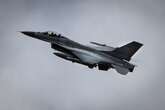A small airplane that looks like a fighter jet but doesn’t bear a single weapon could be a pathfinder towards a reinvention of commercial aviation—or a flying footnote destined for a spot in a museum.
Boom Supersonic’s XB-1 testbed airplane has high odds of being the first privately funded aircraft to shoot through the sound barrier. But that accomplishment won’t matter much unless this startup can then build its Overture airliner, a delta-winged, four-engined jet designed to fly at Mach 1.7 and cut many transatlantic flight times in half.
And then Boom will have to guide Overture through an environment that may be as tricky as transonic flight: safety certification on both sides of the Atlantic prior to revenue service that it hopes to see begin in 2030.
Boom CEO Blake Scholl professes his confidence during an August visit to Boom’s facility at Mojave Air & Space Port in California’s high desert: “It’s not impossible, because it’s been done before.”
Boom’s flight plan
Boom’s version of a minimum viable product is a single-aisle passenger jet optimized for a single market: the shorter set of trans-Atlantic flights that start with the lucrative New York to London route.
Overture will carry from 64 to 80 passengers, depending on seat layout, in an all business-class configuration and cut existing travel times in half: Instead of six to eight hours to go from Newark or JFK to Heathrow, depending on the direction, Overture should soar across the pond in three and a half.
Its service range of 4,250 miles would also cover such common trans-Atlantic routes as Washington to Frankfurt, while trans-Pacific routes would require refueling stops.
United Airlines and American Airlines have placed orders with Boom, both with language stipulating that Overture must meet their own operational and safety requirements: United signed up for 15 in 2021, with American following a year later with a 20-plane order. Boom expects more orders to come, having built a 179,000-square foot structure in Greensboro, North Carolina, that will hold an assembly line capable of constructing 33 Overtures a year.
Scholl says airlines should be able to print money with this jet.
“The economic goal is to be highly profitable at the same kind of fares that people already pay in business class,” he says. “The break-even fare with 80% of the seats full is $3,500.”
That’s well below typical transatlantic biz-class fares, but a veteran airline-industry analyst questions Scholl’s math.
“The pilots are going to demand a hefty premium to fly a supersonic plane,” says Henry Harteveldt of Atmosphere Research. And, he notes, if airlines thought they could make that much more money from a supersonic airliner, they would have asked for one after the 2003 retirement of the pioneering Concorde.
“Some airline somewhere would have gone to some aircraft manufacturer,” he observes. “We didn’t see that from Emirates,” Harteveldt says of the famously spendy Dubai-based airline.
Boom has also signed up the defense contractor Northrop Grumman to explore possible defense and government versions for purposes like VIP transport or express delivery of compact cargo—an answer, Scholl suggests, to a question like “how quickly can we get something to Taiwan?”
The 2020s are not the 1960s
But a new supersonic airliner would benefit from another half century of progress in aerospace engineering.
“We’ve made improvements to fuel efficiency,” says Chris Combs, a professor of aerodynamics at the University of Texas at San Antonio. “We’ve learned things about reducing drag. There’s been a lot of materials-design advances.”
For example, like such modern airliners as Boeing’s 787 and Airbus’s A350, Overture will be built from carbon-fiber composite structures instead of the traditional aluminum. That should make for a lighter and more fuel-efficient aircraft—and composites don’t expand nearly as much as aluminum when heated by supersonic speeds.
Overture’s turbofan engines, unlike Concorde’s much less efficient turbojets, will not require fuel-guzzling afterburners to break Mach 1 and will comply with today’s strictest noise regulations during takeoff and landing. Like Concorde, Overture will still generate a sonic boom, so it will max out at Mach .94 over land, about 20% faster than today’s airliners, and only accelerate past Mach 1 over oceans.
Scholl notes that Overture’s design speed of Mach 1.7—down from the Mach 2.2 the company touted back in 2016—is itself a compromise in favor of fuel efficiency.
Overture’s four Symphony engines, now in the later stages of design by a group of companies led by Florida Turbine Technologies, a subsidiary of the firm Kratos Defense, can also fly on 100% “sustainable aviation fuel” made without fossil fuels. If, that is, SAF suppliers can make enough of it.
Admitting that “today there isn’t enough of it, and it costs too much,” Scholl says Boom is banking on advances in making SAF starting with carbon dioxide pulled out of the air.
Finally, Overture will dispense with one of Concorde’s weirder design quirks, the hinged “droop snoot” that pilots would lower for takeoff and landing to improve their visibility during its high takeoff and landing angles. Overture will pitch up about as high at landing but will use cameras to provide a synthetic view inside the cockpit—one technology XB-1 has already demonstrated during three test flights to date.
A long taxi to the runway
Unfulfilled promises of a revival of supersonic travel have repeatedly disappointed aviation enthusiasts in this century, and Boom’s predictions of its progress have repeatedly fallen short. For example, in 2016 it projected that it would have the XB-1 flying by the end of 2017, but that debut did not happen until March.
That aircraft, powered by three older-generation GE J85 turbojets, has now flown two more times, with plans for a first supersonic test flight by the end of the year.
“This is a flying data-collection machine,” Scholl says in a hangar next to the XB-1, its carbon-fiber fuselage gleaming and its canopy open for a peek at the jet’s cockpit. “There are zero parts in common between XB-1 and Overture, but there is 100% in common in engineering learnings.”
As for Overture, Scholl says Boom has begun building test parts for components like fuselage frames and windows (which will be much larger than Concorde’s) and is months away from freezing the airframe design.
“We will be at firm configuration no later than the end of the year,” he says. Scholl predicts that Boom can then get Overture through prototype manufacturing, test flights, and safety certification in five years. Industry experts have questioned that ambitious schedule, with Boom’s own projections now putting Overture’s first flight in 2027.
“It’s going to be a hard schedule to hit,” says Combs, calling seven to eight years “a little more comfortable.”
Scholl points to a precedent set by Boeing—not the beleaguered airframer of today’s headlines, but “the old good Boeing of the 1990s” that took the 777 from a completed design to FAA certification and passenger service in five years.
“Is there a guarantee we’ll hit that? No,” Scholl allows. He also recognizes that Boom will require more funding along the way: “We’ve known from day one that this is a capital-intensive thing to do.”
But Scholl says Boom is working to improve its chances by inviting FAA scrutiny of its efforts early on. He compares Boom’s openness to ongoing feedback from the agency with a prevailing mindset in which companies “develop kind of in a vacuum and then at the end say, come grade my homework.”
Overture’s engines—a space left conspicuously blank in the aircraft’s concept until the December 2022 unveiling of the Symphony design and contractors—may be especially tricky, considering how different their operating regime will be from every other passenger jet engine in service today.
And even subsonic engines take time: The GE9X, the large turbofan that will power Boeing’s long-delayed 777X, had its first full test on the ground in April of 2016, six months after GE finalized its design, then earned FAA certification in October of 2020.
Farther out on the radar
Harteveldt pronounces himself cautiously optimistic that Boom can get Overture flying and can see airlines making room for such a small, special-purpose subfleet—citing not the precedent of Concorde but Boeing’s long-range 747SP, which airlines like Pan Am used in the 1970s to debut nonstops like New York to Tokyo. But he remains skeptical that Boom can expand its market beyond Concorde’s transatlantic niche.
For example, he doesn’t share Scholl’s optimism about Boom working for transpacific flights with a refueling stop in places like Alaska or Tahiti (“the art will be not letting the passengers off,” Scholl jokes of the second waypoint). Says Harteveldt: “Any airplane that’s going to have to make a refueling stop is going to lose.”
He also questions Boom’s plans for an Overture 2, which Scholl describes as a smaller plane “sized to do about Vancouver to Miami” that will feature a new engine designed in-house and could be designed to generate a quieter sonic boom—should the FAA replace its current outright ban on civil supersonic flight with a noise-based limit.
Wrong market, Harteveldt responds: “Blake, what I need is a plane that can fly New York to Dubai, San Francisco to Singapore, San Francisco to Tokyo.”
Combs, meanwhile, wants to see Boom taking notes on NASA’s X-59, a flat-billed experimental plane built to generate much less of a sonic boom. He predicts: “If you can design an airframe so it creates a sonic thump instead of a sonic boom, it opens up all sorts of overland routes.”
Scholl’s long-term vision involves not just those domestic routes but growing demand for supersonic travel diminishing the market for subsonic airliners. He says: “The market for supersonic jets is going to be larger than the market for subsonic jets.”
First, though, his company needs to build Overture, get it in the air, get it past the speed of sound and get it past safety regulators.
“What they’re doing is neat, and I’d love to see a supersonic passenger airliner as much as everybody,” says Combs. “But I appreciate the challenge of what they’ve undertaken.”






No comments